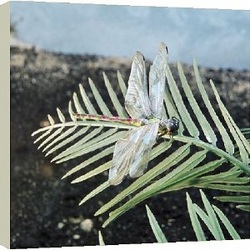
What scientists believe the Griffenfly looked like
The Great Giants of the Paleozoic Era
By Ava Hicks
The largest insects to ever roam the Earth lived 543-248 million years ago. These guys were nothing to mess around with, almost all of them would have to be measured in feet. Only ten percent, although, were massive enough to be considered giant. Being one of the quickest predators of their time, they were all mostly carnivorous, some more violent than others. Of course, they weren't the only creatures on Earth at the time, but most of the others were marine animals, later to evolve into land animals. An example of this would be the 'Mega-scorpion,' a marine scorpion that was an average of three feet long, but was thought to have reached lengths of around seven feet in some cases. Over time, the scorpion grew lungs and was gradually forced onto land, making a larger version of today's. The largest insect fossil ever to be found was an ancient 'Griffenfly' from the Paleozoic era, naturally. The Griffenfly is a giant insect almost exactly like our well-known dragonfly, only about thirty times bigger. The record holder had a wingspan of an astonishing twenty eight inches-that's over two feet! This beast inhabited Central America during the Permian period, the latest of the Paleozoic periods, hints the scientific name ' Meganeuropsis americana.' Fossils of the species were discovered in Oklahoma and Kansas.
By Ava Hicks
The largest insects to ever roam the Earth lived 543-248 million years ago. These guys were nothing to mess around with, almost all of them would have to be measured in feet. Only ten percent, although, were massive enough to be considered giant. Being one of the quickest predators of their time, they were all mostly carnivorous, some more violent than others. Of course, they weren't the only creatures on Earth at the time, but most of the others were marine animals, later to evolve into land animals. An example of this would be the 'Mega-scorpion,' a marine scorpion that was an average of three feet long, but was thought to have reached lengths of around seven feet in some cases. Over time, the scorpion grew lungs and was gradually forced onto land, making a larger version of today's. The largest insect fossil ever to be found was an ancient 'Griffenfly' from the Paleozoic era, naturally. The Griffenfly is a giant insect almost exactly like our well-known dragonfly, only about thirty times bigger. The record holder had a wingspan of an astonishing twenty eight inches-that's over two feet! This beast inhabited Central America during the Permian period, the latest of the Paleozoic periods, hints the scientific name ' Meganeuropsis americana.' Fossils of the species were discovered in Oklahoma and Kansas.
Oxygen Situation
Three hundred million years ago, oxygen levels were very high. Thirty five percent of the atmosphere was oxygen, compared to today's twenty one percent. Just like today, there was a fair amount of nitrogen in the air. Now there are a bunch of other creatures to breathe it all in. Because of the sky-high oxygen levels, the insects evolved over time to match the amount of oxygen required to be inhaled, without having too much or too little. Scientists continue to have debates on how an oxygen increase would affect the creatures today, and if it would affect humans, also. Even so, most scientists believe that for about half of the Earth's timeline, there was no oxygen in the atmosphere whatsoever. So basically, according to studies, the reason the great beastly insects of the Paleozoic times were so big is because of the massive oxygen levels in the atmosphere.
Three hundred million years ago, oxygen levels were very high. Thirty five percent of the atmosphere was oxygen, compared to today's twenty one percent. Just like today, there was a fair amount of nitrogen in the air. Now there are a bunch of other creatures to breathe it all in. Because of the sky-high oxygen levels, the insects evolved over time to match the amount of oxygen required to be inhaled, without having too much or too little. Scientists continue to have debates on how an oxygen increase would affect the creatures today, and if it would affect humans, also. Even so, most scientists believe that for about half of the Earth's timeline, there was no oxygen in the atmosphere whatsoever. So basically, according to studies, the reason the great beastly insects of the Paleozoic times were so big is because of the massive oxygen levels in the atmosphere.
